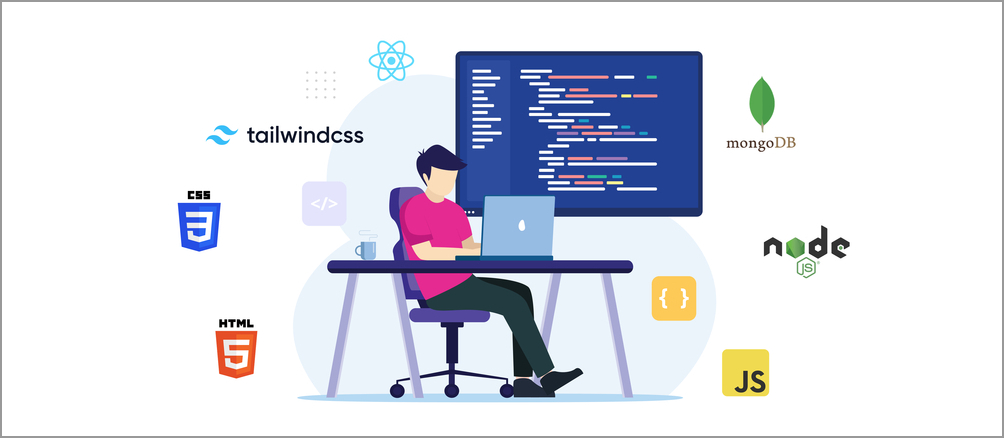Introduction
Have you ever wondered how a website or an app actually works — not just what you see, but everything happening behind the scenes too? That’s where Full Stack Development comes in.
In today’s digital world (especially in 2025 and beyond), businesses need web applications that are fast, smart, and seamless. This demand has skyrocketed the need for full stack developers — the tech all-rounders who can handle everything from designing beautiful interfaces to managing powerful servers.
In this guide, you’ll learn exactly what fullstack development means, the skills involved, popular technologies, career scope, and how you can start your journey even if you’re a complete beginner.
What is Full-Stack Development?
Full stack development means working on both the frontend (what users see and interact with) and the backend (where the data is processed and stored).
A full stack developer can build an entire web application — from the user-friendly design to the heavy lifting happening on servers.
Think of it like a restaurant:
- The frontend is the waiter and menu — it’s what customers (users) interact with.
- The backend is the kitchen — where the real action happens, like cooking and preparing the food (data and logic).
- A full stack developer knows how to manage both the waiter and the kitchen!
Key Components of Full-Stack Development
A. Frontend Development
This is everything users can see and interact with — buttons, menus, forms, animations.
Key technologies:
- HTML (structure)
- CSS (styling)
- JavaScript (interactivity)
- Popular frameworks: React, Vue, Angular
B. Backend Development
This is the brain of an application. It manages how data is created, stored, and moved.
Common tools and languages:
- Node.js, Python (Django, Flask), Java (Spring Boot), PHP, Ruby
- Databases like MongoDB, MySQL, PostgreSQL
C. APIs and Databases
- APIs (Application Programming Interfaces) allow the frontend and backend to communicate.
- Databases store user information, product details, orders, and everything else an app needs.

Popular Full-Stack Technologies (Stacks)
Here are some of the most popular “full stack technologies” — sets of technologies used together:
- MERN: MongoDB, Express.js, React, Node.js
- MEAN: MongoDB, Express.js, Angular, Node.js
- LAMP: Linux, Apache, MySQL, PHP
- Django + React: Django (Python backend) + React (frontend)
- Ruby on Rails: Full-stack web application framework for rapid development
Each stack is powerful and comes with its own strengths depending on the project needs.
Skills Needed to Become a Full-Stack Developer
Technical skills:
- Frontend basics: HTML, CSS, JavaScript
- Server-side language (Node.js, Python, PHP, etc.)
- Database management (SQL, NoSQL)
- Version control (Git, GitHub)
Soft skills:
- Problem-solving mindset
- Effective communication
- Time management and collaboration
Mindset tip:
The world of tech changes fast. A willingness to learn continuously is your biggest asset.
Why Choose Full-Stack Development? (Benefits)
- Versatility: Handle a complete project independently.
- High Demand: Companies love developers who can work across the board.
- Better Salaries: Full stack developers often earn more than specialists.
- Entrepreneurial Freedom: Build and launch your own apps without needing a huge team.
Challenges of Full-Stack Development
- Steep Learning Curve: You have to master multiple areas.
- Fast-Changing Tech: Frameworks and tools evolve quickly.
- Risk of Being a Generalist: Without deep skills in at least one area, it’s easy to get lost.
Tip:
Master the basics deeply first. Then gradually expand your stack knowledge.
India 2025: Career Path and Job opportunities
Entry-Level Roles:
- Junior Full Stack Developer
- Junior Web Application Developer
Mid-Level Roles:
- Full Stack Developer
- Software Engineer
Senior Roles:
- Technical Lead
- Solutions Architect
- CTO (especially in startups)
Salary Expectations for a Junior Full stack Developer role (2025):
- Entry Level: ₹6–10 LPA (depending on the org)
- Mid-Level: ₹9–14 LPA (Usually, can be more)
- Senior Level: ₹15 LPA and beyond (depending on expertise)
How to Start Your Journey as a Full-Stack Developer
Simple Roadmap:
- Learn HTML, CSS → Build simple websites.
- Master JavaScript → Make websites interactive.
- Learn a frontend framework (React, Vue).
- Dive into backend programming (Node.js, Python, etc.)
- Understand databases (MongoDB, MySQL).
- Build real-world projects (portfolio is key).
- Learn about version control (Git/GitHub).
Resources:
- Free online tutorials (MDN Web Docs, freeCodeCamp)
- Structured courses and bootcamps
- Build passion projects and collaborate with peers
Conclusion
Full stack development is an exciting, rewarding path for anyone who wants to create full-fledged applications and shape the future of technology.
Remember: Every expert was once a beginner.
If you’re consistent, curious, and committed, you can become a successful full stack developer.
Ready to start your journey?
Take a beginner-friendly course or check out a full stack developer career roadmap tailored for 2025 needs!
Frequently Asked Questions (FAQ)
A: It’s the ability to build both the frontend (what users see) and backend (the logic and database) of a website or app.
A: Not initially. You can start with one and gradually learn the other. Being comfortable with both is the goal.
A: Yes! It’s challenging but rewarding. Many developers start with fullstack development because it gives a complete understanding of web development.
A: MERN (MongoDB, Express, React, Node.js), MEAN (Angular instead of React), and Django + React are among the most popular.
A: In India, average salaries range from ₹8–14 LPA depending on skills, projects, and company.
